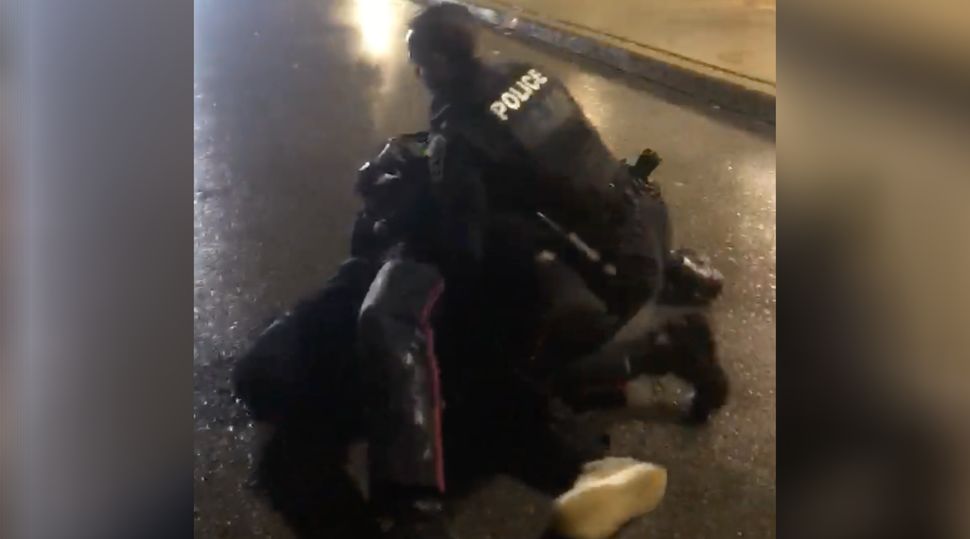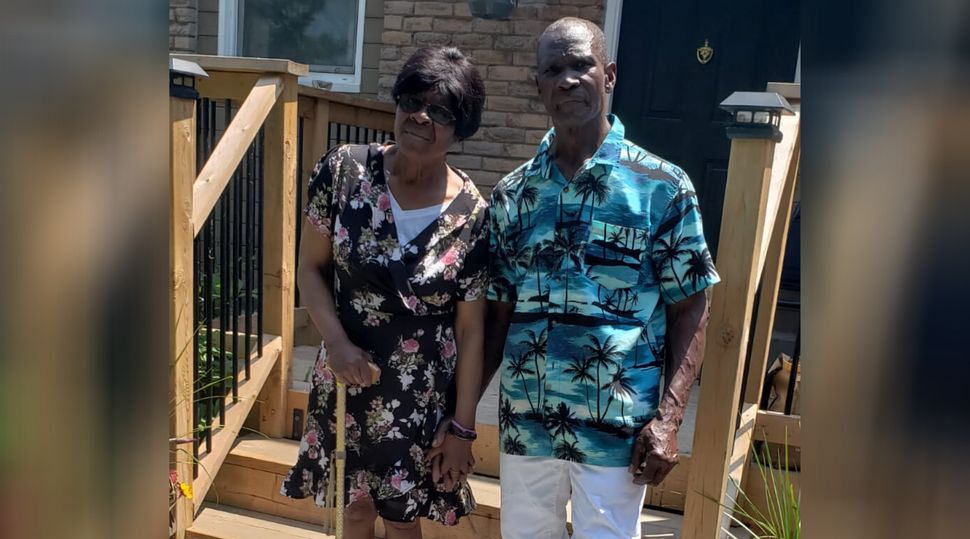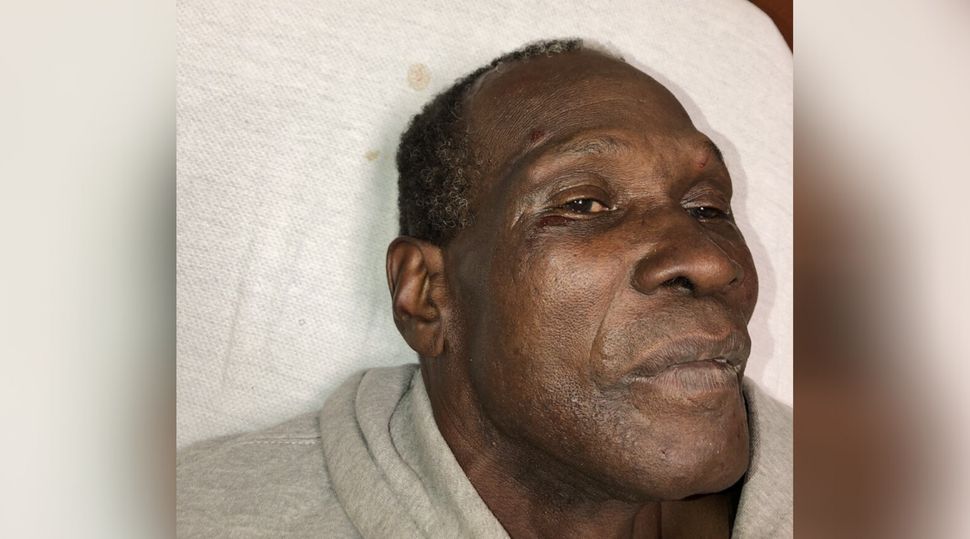TORONTO — Livingston Jeffers accompanied his wife Pamelia to the emergency department of an Ontario hospital one night in October 2018, seeking relief for her insomnia and stomach ache. Their grandson dropped them off, believing his grandmother would get the help she needed.
Hours later and tired of waiting, the Black couple, who are both in their 60s, attempted to leave the Lakeridge Health hospital in Ajax, Ont., said their lawyer.
Outside, they were stopped by a nurse, security guards and then two police officers. The nurse thought Pamelia was to be held at the hospital for up to 72 hours to see a psychiatrist, an order known as a Form 1, according to witness statements compiled in a police report. A doctor later told police that Pamelia was exhibiting signs of delusion and paranoia and he was in the process of completing the form.
Within minutes, the situation escalated, with police pinning Jeffers to the ground, punching and elbowing him four times in the face, as he screamed “Murder, murder, murder,” until he was nearly unconscious, the police report said.
When their grandson Tre returned to the hospital to pick them up later that night, he was shocked to find Jeffers slouched in a chair not moving, with bruises on his face and handcuffed.
“I couldn’t believe it. A hospital is where you go when you’re sick or need help.”
- Tre, the couple's grandson
What happened when the Jeffers were at the hospital is complicated, and raises questions about why the situation quickly escalated, and what could have been done by hospital staff and police to prevent the violent altercation.
“I couldn’t believe it. A hospital is where you go when you’re sick or need help,” Tre, 22, told HuffPost Canada. He requested his full name not be used out of concern for his safety. “I thought, ‘Wow this is our system. It’s scary.’”
Investigators determined Durham police had used a reasonable amount of force, but “cherry picked” evidence to charge Jeffers with assault, said his lawyer Faisal Kutty in a letter to the Office of the Independent Police Review Director (OIPRD), which handles public complaints made against police. All charges against Jeffers were dropped once a video surfaced of the incident — a video witnesses allege police instructed them to delete.
“This case suggests that elderly Black people must weigh the dangers to their personal safety and exercise extra vigilance when attempting to leave a hospital,” Kutty wrote. The Jeffers are requesting the office reinvestigate the case, and declined HuffPost’s request to comment.
“What has occurred in this instance was an egregious act of police overreach, use of excessive force against two elderly and vulnerable individuals and abuse of authority when demanding that witnesses delete their videos.”

The Jeffers’ story made headlines this week with the public release of the videos, as Canadians acknowledge the systemic racism rife in our institutions. Pressure continues to mount for an overhaul of police forces that are quick to use violence against Black Canadians, Indigenous people and other racialized people, following the recent police killing of George Floyd in the U.S., and the Toronto-area deaths of Regis Korchinski-Paquet and D’Andre Campbell.
But the Jeffers’ experience in the hospital, before police became involved, also highlights the discrimination Black Canadians and people who experience mental health challenges face in the health-care system, said Toronto clinical psychologist Dr. Taslim Alani-Verjee, who researches the health and wellbeing of racialized people. She reviewed the Jeffers’ case, but spoke generally.
“We expect, rightfully so, for health professionals to approach their patients with care and compassion but that turned into aggression and frustration — we see that way more with Indigenous and people of colour,” Alani-Verjee said.
“They’re often mistrusted within the health-care system, and are thought to be more likely to be violent and aggressive, leading to very quick escalation.”
Report paints husband as the aggressor: lawyer
In his letter to OIPRD, Kutty said Lakeridge Health staff failed in their handling of the situation.
“The attending physician, nurses and officers all note in their statements that Mr. Jeffers appeared disturbed, but took no action to address this appropriately,” Kutty wrote.
“The investigative report’s depiction of events without their context paints Mr. Jeffers as the aggressor. Examining Mr. Jeffers’ actions in context, however, clearly illustrates that he was acting out of fear and distress.”
Due to patient confidentiality, Lakeridge Health said it could not speak about individual cases, but that “it is committed to working with the communities we serve to promote a just and equitable environment for all members of our diverse community, including those who are most vulnerable.”

Tre dropped off his grandfather and grandmother at the hospital around 6:30 p.m. on Oct. 30, 2018.
More than three hours later, Pamelia was assessed by a doctor who determined she was “delusional and paranoid” and advised that she see the hospital’s crisis intervention team, according to medical records supplied by the Jeffers’ lawyer.
The crisis team includes a nurse or social worker who helps to de-escalate situations, consults with the patient, and suggests possible treatments and community resources, hospital spokesperson Sharon Navarro said in a statement. In most cases, the patient is discharged. Sometimes patients are admitted to the mental health unit.
That crisis team, however, wasn’t staffed the night of the Jeffers’ visit, so the doctor advised Pamelia that she should go home and return the next day, according to the police investigation report.
(Since this incident, the hospital’s crisis team has become available 24/7.)
The doctor wrote in his note that Pamelia “never tried to hurt anybody or herself.” However, shortly after the assessment, he decided to place Pamelia on the Form 1, which would require her to remain on site. He later told police investigators he couldn’t remember why he changed his mind.
A nurse told the Jeffers that Pamelia now couldn’t leave the hospital and then left to prepare the form, according to the police report. Their medical records show that the hospital did not issue the Form 1 for Pamelia until after the violent incident with police.

Security footage from the hospital showed the Jeffers walking out of the hospital. The nurse, alerted by a colleague that they were leaving, followed them out the door and down the sidewalk near the ambulance bay, joined by two security guards. She was trying to explain that Pamelia wasn’t allowed to leave, but Jeffers “refused to listen,” according to the police report.
The nurse described him as “very angry” and said she was “afraid for her safety as he was yelling and very close to her.” One of the security guards described Jeffers as “confused,” said the police report.
Intersection of ethnicity and mental health
Little data is collected about racialized Canadians, making it difficult for researchers to study how ethnicity intersects with health care and mental health.
But studies do suggest that Black Ontarians experience double the wait times to get evidence-based mental health support than their white counterparts, and are more likely to be restrained or confined in the mental health and addictions system.
Mentally ill patients generally experience “some of the most deeply felt stigma” from doctors and nurses, and feel “patronized, punished or humiliated,” reported the Mental Health Commission of Canada in 2013. Front-line workers tend to misattribute unrelated symptoms and complaints to mental illness, and be pessimistic about a patient’s chance of recovery, while lacking training and skills to treat mental illness.
Health-care workers also tend not to explain processes, such as a Form 1, as effectively to racialized patients and their families, compared to white people, said Alani-Verjee.
“And when it comes to treatments, medications and side effects, health care professionals, for whatever reason, don’t take the time to explain those things and Black and Indigenous people feel less empowered to ask questions and challenge people in positions of authority,” she said.
Watch: How people of colour are affected by mental health issues. Story continues after video.
There’s also evidence to suggest Black people are not taken seriously by health-care workers when they seek out treatment for physical ailments.
A landmark 2016 study found that systemically, Black Americans do not receive adequate treatment for pain because of health professionals’ racial bias, including the assumptions they will abuse medications, don’t feel pain as intensely as white people and other false beliefs.
Anecdotally, Black Canadians have reported similar failings in Canada’s health-care system. Canadian Rapper John River, whose real name is Matthew John Derrick-Huie, posted to social media in 2018 that he was experiencing chest pain, and despite visiting five Toronto-area hospitals, had not received medical treatment.
He ended up having to wait two months for an emergency procedure and in the meantime faced allegations he was a drug dealer or user, or imagining his symptoms.
“The manner of the intervention displayed by police remains unacceptable.”
- Faisal Kutty, lawyer
The Jeffers incident also calls into question if police responded appropriately to the situation.
“The manner of the intervention displayed by police remains unacceptable,” Kutty wrote in his letter to OIPRD. “We assume you’d agree with us that it would be odd to allow two police officers to nearly beat a 68-year-old man unconscious ostensibly to prevent him from harming himself.”
Two police officers were at the hospital that October night for an unrelated call when they heard yelling and walked up to the scene with the Jeffers, the nurse and the security guards, according to the police report. The nurse told the officers that Pamelia was being held on a Form 1, and wasn’t allowed to leave the hospital.
“Brother, take it easy. Please don’t hold on to me,” Jeffers said to officer Alex Edwards, as captured in body camera footage and partially transcribed in the police report. “I didn’t do you all nothing. Please take it easy brother and keep off of me.”
Jeffers told the police that people were trying to murder him and his family.
“This is going to go one of two ways,” said Edwards. “Now take a deep breath, take a deep breath.”
Jeffers told the officer that Pamelia did not want to stay in the hospital.
“You don’t have a choice,” Edwards said, putting his hand on Jeffers’ chest, attempting to separate him from his wife, according to the police report.
“Brother, easy, what am I doing?” Jeffers asked. He raised his arm “toward” Edwards, according to the transcript.
Within one minute of intervening, the police pinned Jeffers to the ground.

Edwards told investigators the move was intended to de-escalate the situation, and he used his body weight to stop the grandfather from moving. Jeffers scratched Edwards’ face, and the other officer, Iyan Dusko, punched Jeffers in the head.
That’s when Jeffers screamed, “Murder, murder, murder.”
Edwards told investigators that he then “felt the pulling and tug on his use of force belt” where his gun was hoisted and yelled “Let go of my gun!” In response, Dusko punched Jeffers in the head, and then handcuffed him. Jeffers later said in his statement to investigators that it felt like he was struck with “something heavy” before blacking out.
Only one witness said they saw Jeffers reach for Edwards’ gun, and that witness did not have a clear view of the incident, according to their interview in the police report.
After the struggle, as the officers were escorting Jeffers to the hospital, Edwards said, according to the body camera video, “Why were you fighting us? What was going on? How much sense did that make?”
“That’s what you get for fighting us,” said Dusko.
“I not fight you guys. I just didn’t want me wife to be taken,” Jeffers responded.
Two witnesses filmed the incident on their phones, but were told by hospital staff and police to delete the videos, said Kutty. Only part of one video was not deleted, and shows officers pinning Jeffers to the ground, as he screams, while Pamelia is held back by security guards. She is also screaming.
Jeffers was restrained to a hospital bed, with a head injury. He and Pamelia were kept in the psychiatric ward overnight. In the morning, the doctor assessed both Jeffers, determined Pamelia “was not suicidal or homicidal at all” and they were discharged.
Jeffers filed a complaint against Durham police through OIPRD, alleging unnecessary exercise of authority and discreditable conduct. OIPRD assigned the investigation to another Toronto-area police service, York Regional Police, which determined the only thing officers did wrong was fail to advise Jeffers of his right to counsel.
The Jeffers have requested that OIPRD re-investigate their case, and have filed a civil lawsuit against Durham police and the hospital.
The investigation failed to address whether the hospital actually had the authority to keep Pamelia in its care, as the doctor was in the process of signing the Form 1 when they left, said Kutty in a letter to OIPRD dated June 10.
It also didn’t address the allegations that police told witnesses to delete their videos of the incident, or what other options the officers had to de-escalate the situation given no dangerous crime was occurring, said the letter.
“He was lucky he wasn’t a George Floyd.”
- Tre, the couple's grandson
Durham Regional Police declined to comment, and OIPRD has 30 days to respond to the Jeffers’ request.
At the hospital, Pamelia never got treatment for her stomach ache, said Tre. The Jeffers were so traumatized, that even after counselling, they’ve refused to go to another Canadian hospital, and have instead travelled abroad for medical treatment.
The incident has also profoundly impacted Tre, who has tried to make sense of the night he dropped his grandparents off at the hospital.
“How can you ever forget something like that?” he said. “Even when I go to the doctor’s, I always think about it. Imagine if they misunderstood me? I think it won’t go there, but how did it go there for my grandfather?”
Even with Black Lives Matter protests taking place across North America, he can’t help but think that “the system” won’t change for a very long time.
“Imagine if my grandparents hadn’t called for me to pick them up? Imagine there were no witnesses? Where would this have all went?
“He was lucky he wasn’t a George Floyd.”